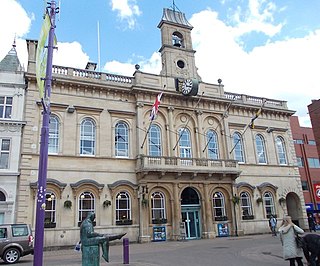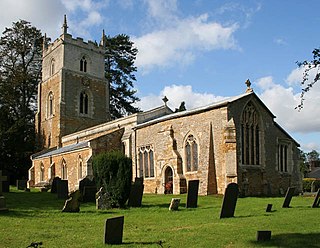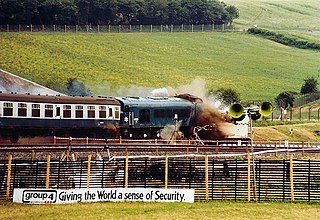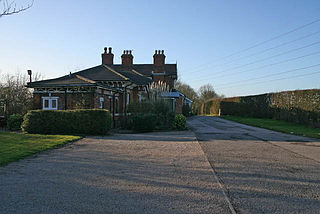
Leicestershire is a ceremonial county in the East Midlands of England. It is bordered by Derbyshire, Nottinghamshire, and Lincolnshire to the north, Rutland to the east, Northamptonshire to the south-east, Warwickshire to the south-west, and Staffordshire to the west. The city of Leicester is the largest settlement and the county town.

Melton Mowbray is a town in the Melton district in Leicestershire, England, 19 miles (31 km) north-east of Leicester, and 20 miles (32 km) south-east of Nottingham. It lies on the River Eye, known below Melton as the Wreake. The town had a population of 27,670 in 2019. The town is sometimes promoted as Britain's "Rural Capital of Food"; it is the home of the Melton Mowbray pork pie and is the location of one of six licensed makers of Stilton cheese.

Oakham is the county town of Rutland in the East Midlands of England, 25 miles (40.2 km) east of Leicester, 28 miles (45.1 km) south-east of Nottingham and 23 miles (37.0 km) north west of Peterborough. It had a population of 12,149 in the 2021 census. Oakham is to the west of Rutland Water and in the Vale of Catmose. Its height above sea level ranges from 325 to 400 ft.

Melton is a local government district with borough status in north-eastern Leicestershire, England. It is named after its only town, Melton Mowbray. The borough also includes numerous villages and surrounding rural areas. The north of the district includes part of the Vale of Belvoir. Melton is the least populous district of its type and the fourth least populous district in England overall.

Bottesford is a village and civil parish in the Borough of Melton in the ceremonial county of Leicestershire, England. It lies close to the borders of Nottinghamshire and Lincolnshire.

Langham is a village and civil parish in Rutland in the East Midlands of England. The village is about 2 miles (3 km) north-west of Oakham, on the A606 main road linking Oakham and Melton Mowbray.

Burrough-on-the Hill is a small village and former civil parish, now in the parish of Somerby, in the Melton district, in the county of Leicestershire, England. It is 12 miles (19 km) north east of Leicester. The parish church is St. Mary the Virgin. Burrough Hill is an Iron Age hill fort near the village and is in an 86-acre (35 ha) country park of the same name. The hillfort stands on a promontory around 660 feet (200 m) above sea level, 7 miles (11 km) south of the modern settlement of Melton Mowbray. In 1931 the parish had a population of 214.

The Loughborough Town Hall is a building fronting onto the Market Place in Loughborough, Leicestershire, England. Built as a corn exchange and ballroom in 1855, it later became a municipal building and subsequently a theatre. It is a Grade II listed building. The building is still used for full council meetings of Charnwood Borough Council.

The A606 is an A road in England that starts in West Bridgford, on the outskirts of Nottingham, and heads southeastwards through Leicestershire and the towns of Melton Mowbray and Oakham, terminating at Stamford, Lincolnshire on the former Great North Road.

The River Eye is a slender, slow-flowing river in north-eastern Leicestershire, England. The river is known to flood periodically; especially within the town Melton Mowbray. Fine sediments from agricultural fields, the biggest known cause for the floods, have been recognized as a major source to the channel's supply. The river meanders throughout north-east Leicestershire where is it primarily flanked by farmland, and only crosses a handful of villages/towns. The primary wooded area it crosses is the fox covert. The farming in the district is largely made up of pasturing sheep and cows. Stilton and Red Leicester cheeses originally came from the villages and dairy farms in the Eye basin.

Knipton is a village and former civil parish, now in the parish of Belvoir, in the Melton district, in the county of Leicestershire, England. It lies about 6 miles (10 km) from the town of Grantham, just off the A607, and 10 miles (16 km) from Melton Mowbray. It borders the Duke of Rutland's estate at Belvoir Castle. Although the village is in Leicestershire, it has a Nottinghamshire postcode and a Lincolnshire (Grantham) STD code. In 1931 the parish had a population of 273. On 1 April 1936 the parish was abolished and merged with Belvoir.

Thorpe Arnold is a farming village and former civil parish, now in the parish of Waltham on the Wolds and Thorpe Arnold in the district of Melton, which is approximately 1.2 miles (1.9 km) northeast of Melton Mowbray in Leicestershire, England. In 1931 the parish had a population of 128. On 1 April 1936 the parish was abolished and to form Waltham.

Leicester Corn Exchange is a commercial building in the Market Place in Leicester, Leicestershire, England. The structure, which currently operates as a public house, is a grade II* listed building.

Grimston was a railway station serving Saxelbye village in the English county of Leicestershire. It was opened on the Nottingham direct line of the Midland Railway between London and Nottingham via Corby.The station was formerly named Saxelbye, the name was changed after only 3 months to avoid confusion with Saxby, a few miles east of Melton Mowbray, on the Midland's other line between Leicester and Peterborough. The village of Grimston lies about one mile to the north west of the former Grimston station. The line still exists today as the Old Dalby Test Track.

Old Dalby railway station served Old Dalby in the English county of Leicestershire. It was opened on the Nottingham direct line of the Midland Railway between London and Nottingham, avoiding Leicester. The line still exists today as the Old Dalby Test Track.

Upper Broughton was a railway station serving Upper Broughton in the English county of Nottinghamshire. It was opened on the Nottingham direct line of the Midland Railway between London and Nottingham, avoiding Leicester. The line still exists today as the Old Dalby Test Track.

Plumtree railway station served Plumtree in the English county of Nottinghamshire, on the Nottingham direct line of the Midland Railway between London and Nottingham, avoiding Leicester. The station is now closed, although the line still exists today as the Old Dalby Test Track.

Rutland, archaically Rutlandshire, is a ceremonial county and unitary authority in the East Midlands of England. It borders Leicestershire to the north and west, Lincolnshire to the north-east, and Northamptonshire to the south-west. Oakham is the largest town.
Edwalton railway station served the village and district of Edwalton in the English county of Nottinghamshire. It was opened on the Midland Railway Melton direct route between London and Nottingham, avoiding Leicester.

Corn exchanges are distinct buildings which were originally created as a venue for corn merchants to meet and arrange pricing with farmers for the sale of wheat, barley, and other corn crops. The word "corn" in British English denotes all cereal grains, such as wheat and barley. With the repeal of the Corn Laws in 1846, a large number of corn exchanges were built in England, particularly in the corn-growing areas of Eastern England.




















